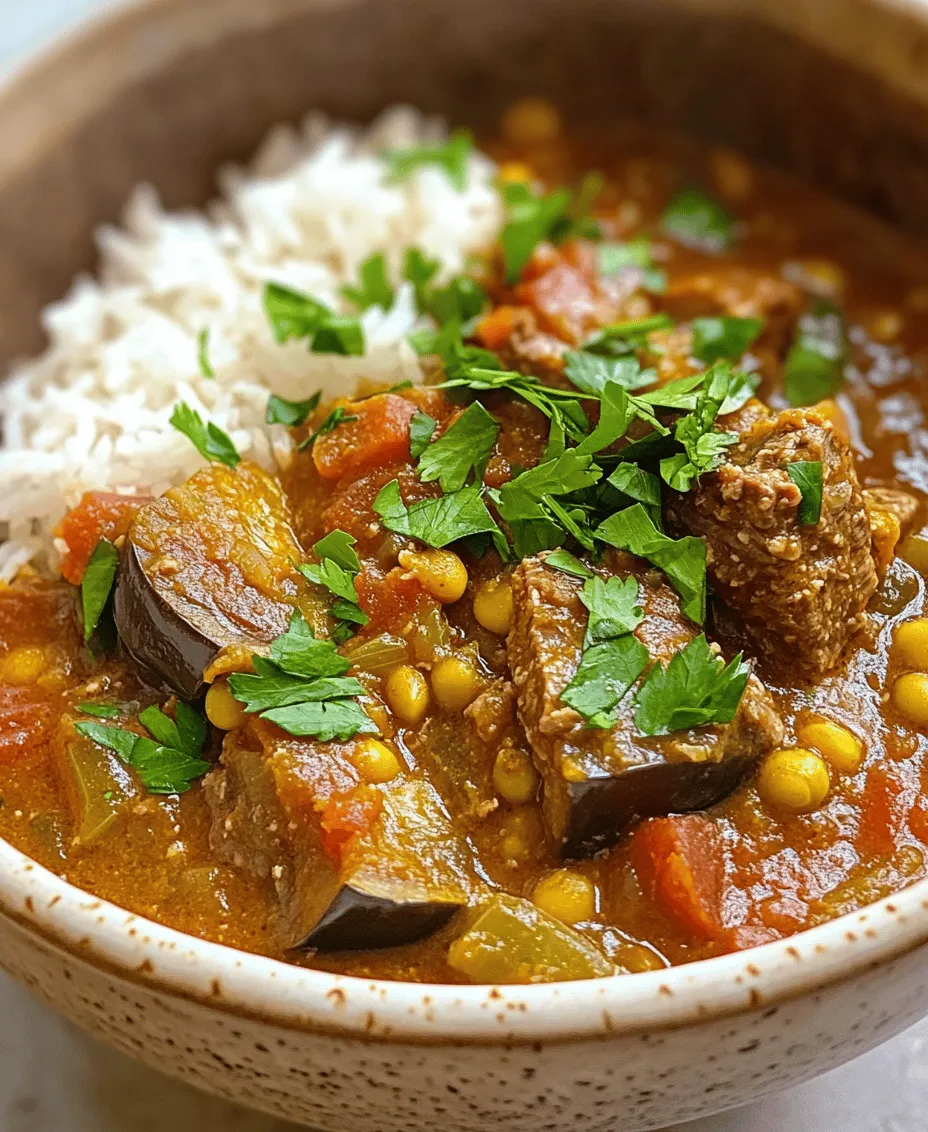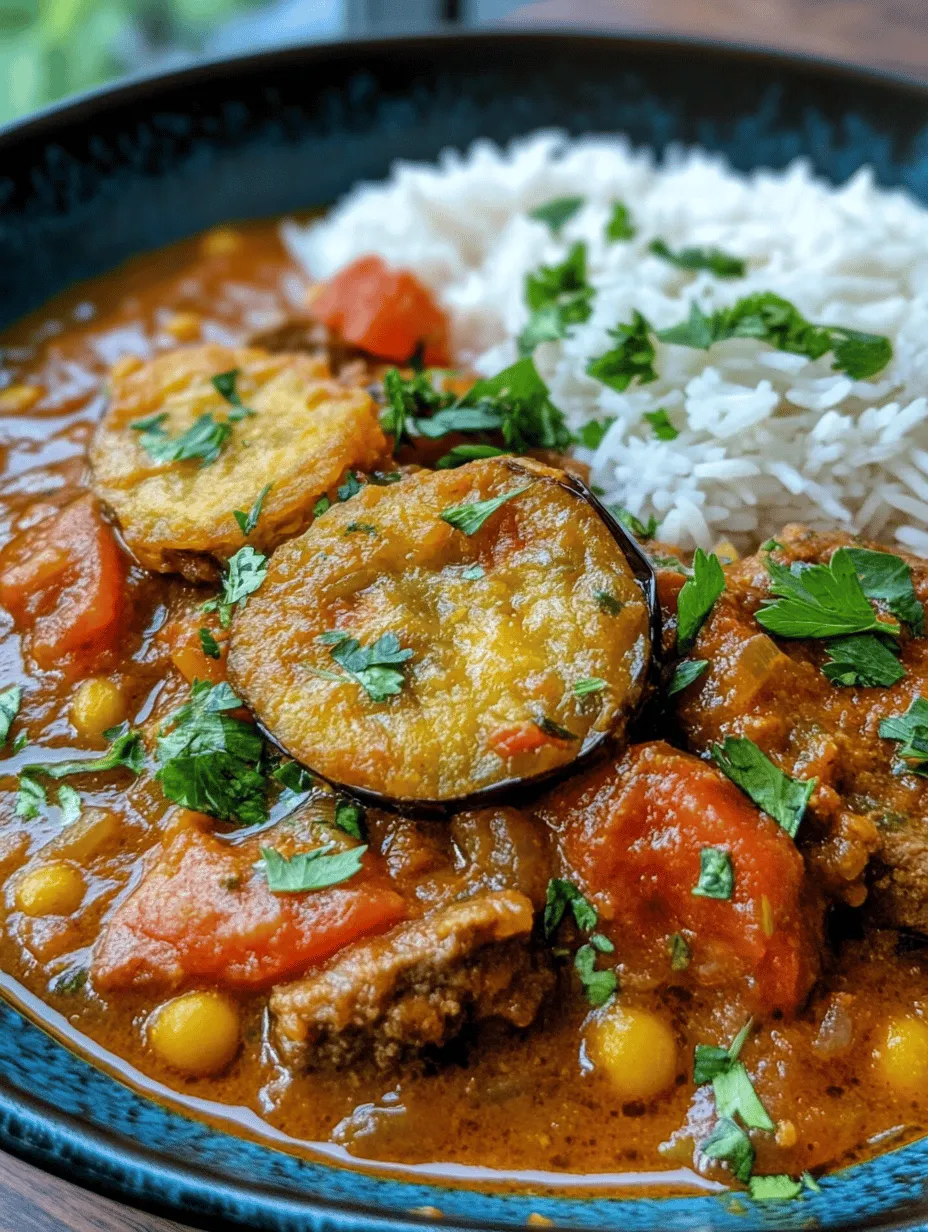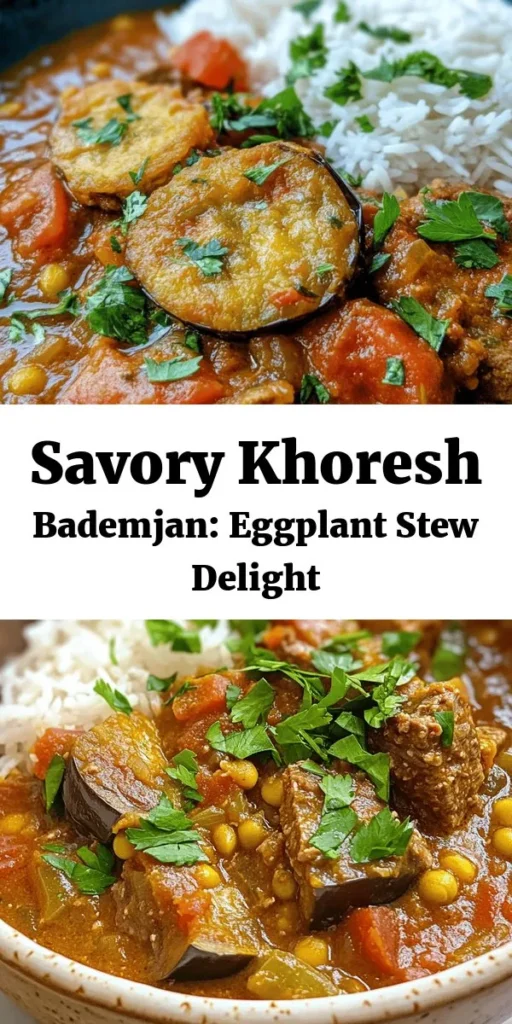Introduction
Khoresh Bademjan, also known as Persian Eggplant Stew, is a quintessential dish in Persian cuisine that embodies the rich tapestry of flavors and traditions found in Iranian cooking. This hearty stew combines the unique taste of eggplant with a medley of spices, creating a comforting meal that warms both the body and the soul. Whether served over saffron-infused rice or enjoyed simply with bread, Khoresh Bademjan has a special place at the dinner table, often gracing family gatherings and festive occasions.
One of the remarkable aspects of Khoresh Bademjan is its versatility. It can be prepared as a vegetarian delight or incorporate tender chunks of meat, catering to a wide range of dietary preferences. The star ingredient, eggplant, is celebrated in Persian cooking not only for its flavor but also for its texture and ability to absorb spices, making it a favorite in many traditional dishes.
In this article, readers will embark on a culinary journey to discover the art of making Khoresh Bademjan from scratch. We’ll explore its historical and cultural significance, break down the essential ingredients, and delve into the preparation steps that lead to a perfectly balanced stew. By the end, you will be well-equipped to create this delightful dish in your own kitchen.
Understanding Khoresh Bademjan
Khoresh Bademjan is more than just a stew; it is a reflection of Persian culture and heritage. Traditionally, this dish is served with rice, often accompanied by pickles or a fresh salad. The layering of flavors—from the rich, savory broth to the tender, caramelized eggplant—creates a harmonious balance that is characteristic of Persian cuisine.
The cultural roots of Khoresh Bademjan can be traced back centuries, as eggplant has been cultivated in the Middle East for thousands of years. In Persian cooking, eggplants are cherished for their ability to soak up flavors, making them an ideal base for stews. Historical texts indicate that eggplants were frequently used in Persian royal kitchens, often prepared with a variety of meats and spices to create luxurious feasts.
In addition to its delicious taste, Khoresh Bademjan offers numerous nutritional benefits. Eggplants are low in calories and rich in dietary fiber, vitamins, and minerals. They contain antioxidants that support heart health and combat oxidative stress. The addition of split yellow peas not only enhances the stew’s texture but also contributes protein and essential nutrients. The spices used in Khoresh Bademjan, such as turmeric and cinnamon, are known for their anti-inflammatory properties, making this dish a wholesome option for any meal.
Ingredients Breakdown
To create a traditional Khoresh Bademjan, you will need a selection of key ingredients that work together to produce its signature flavor. Below is a detailed list of the components that make this dish shine, along with alternatives for those with dietary preferences.
Key Ingredients:
– Eggplants: The primary ingredient, eggplants add a unique texture and absorb the flavors of the stew. Choose firm, glossy eggplants for the best results.
– Split Yellow Peas: These legumes provide protein and a delightful creamy texture. They also help thicken the stew. If you’re looking for a vegetarian option, feel free to increase the amount of yellow peas.
– Onions: Sautéed onions form the flavor base of the stew. They should be cooked until golden and fragrant to enhance the dish’s aroma.
– Garlic: Fresh garlic adds depth and a pungent flavor that complements the other ingredients perfectly.
– Tomatoes: Fresh or canned tomatoes provide acidity and brightness, balancing the richness of the eggplant and peas.
– Spices: A blend of turmeric, cinnamon, and black pepper brings warmth and complexity to the dish.
– Fresh Herbs: Parsley and cilantro are traditional garnishes that add freshness to the final presentation.
Alternative Ingredients:
For those following a vegetarian or vegan diet, Khoresh Bademjan can easily be adapted by omitting meat and increasing the amount of split yellow peas or adding other vegetables like bell peppers or zucchini.
Importance of Fresh Herbs and Spices:
The use of fresh herbs and quality spices cannot be overstated in Khoresh Bademjan. Fresh herbs like parsley and cilantro not only enhance the flavor but also add a vibrant touch to the dish. Similarly, using whole spices and grinding them just before cooking can elevate the taste, offering a more aromatic experience compared to pre-ground spices.
Preparation Steps for Khoresh Bademjan
The preparation of Khoresh Bademjan requires careful attention to detail, particularly when it comes to handling the eggplants. Proper preparation ensures that the eggplants are flavorful and have the right texture, which is essential for the overall success of the dish.
Preparing the Eggplants
1. Salting the Eggplants: Begin by washing the eggplants and cutting them into 1-inch cubes or slices, depending on your preference. To remove any bitterness and excess moisture, sprinkle a generous amount of salt over the cut eggplants and allow them to sit for about 30 minutes. This process draws out moisture and bitterness, resulting in a more flavorful and tender final product.
2. Rinsing and Drying: After the eggplants have released some of their moisture, rinse them under cold water to remove the salt. Pat them dry with a clean kitchen towel or paper towels. This step is crucial as it prevents the eggplants from becoming too soggy during cooking.
Frying the Eggplants
Frying the eggplants is a key step in achieving the desired texture and flavor. Here’s how to do it:
1. Heat the Oil: In a large skillet or frying pan, heat a generous amount of vegetable oil over medium heat. Make sure the oil is hot enough before adding the eggplants to ensure they fry evenly and develop a golden-brown crust.
2. Fry Until Golden: Add the prepared eggplants in batches, ensuring not to overcrowd the pan. Fry them for about 4-5 minutes on each side until they are golden brown and tender. Once cooked, transfer the fried eggplants to a plate lined with paper towels to absorb excess oil.
3. Set Aside: After frying, set the eggplants aside while you prepare the stew base. This step allows the flavors of the eggplants to shine through in the final dish.
Sautéing the Aromatics
With the eggplants prepared, it’s time to build the flavor base of your Khoresh Bademjan.
1. Sauté the Onions: In the same skillet, add a little more oil if needed and heat it over medium heat. Add finely chopped onions and sauté until they are translucent and slightly caramelized, about 6-8 minutes. This step is crucial as it adds a depth of flavor to the stew.
2. Add Garlic: Once the onions are ready, add minced garlic to the pan. Sauté for an additional 1-2 minutes until fragrant, being careful not to let it burn, as burnt garlic can impart a bitter taste to the dish.
By following these initial steps, you set a solid foundation for your Khoresh Bademjan, ensuring that each bite is bursting with flavor. The next stages will involve layering in the remaining ingredients and allowing the stew to simmer, developing its rich and complex taste.

Cooking the Meat (or Chickpeas)
To create a rich and flavorful Khoresh Bademjan, the first step involves browning your choice of meat. Traditionally, this dish is made with beef or lamb, which adds a deep, savory flavor to the stew. Here’s how to achieve the perfect browning:
1. Select Your Meat: Choose cuts of beef such as chuck or brisket, or lamb shoulder for a tender texture. These cuts have enough fat and connective tissue to break down during cooking, enhancing the stew’s flavor.
2. Prepare the Meat: Cut the meat into uniform, bite-sized pieces, about 1 to 1.5 inches. This ensures even cooking. Pat the meat dry with paper towels to remove excess moisture, which helps in achieving a nice sear.
3. Heat the Oil: In a large, heavy-bottomed pot or Dutch oven, heat 2 to 3 tablespoons of vegetable oil over medium-high heat. The oil should shimmer but not smoke.
4. Brown the Meat: Add the meat in batches—avoid overcrowding the pan, as this can lead to steaming rather than browning. Allow the meat to sear without moving it for about 4-5 minutes until a deep brown crust forms. Turn the pieces to brown all sides. This step is crucial as it develops a rich flavor base for your Khoresh.
5. Remove and Set Aside: Once browned, remove the meat from the pot and set it aside. This prevents overcooking while you prepare the other ingredients.
For those seeking a vegetarian option, chickpeas can be a perfect substitute. Use canned chickpeas for convenience or soak and cook dried ones ahead of time. When using chickpeas:
– Drain and Rinse: If using canned chickpeas, drain and rinse them well to remove excess sodium and preserve their texture.
– Sauté for Flavor: In a separate pan, briefly sauté the chickpeas in a bit of oil with some spices before adding them to the stew. This enhances their flavor and ensures they absorb the rich stew sauce during cooking.
Building the Stew
With the meat (or chickpeas) prepped, it’s time to build the layers of flavor that make Khoresh Bademjan so irresistible. Follow these step-by-step instructions:
1. Sauté Onions: In the same pot used for browning the meat, add another tablespoon of oil if needed. Reduce the heat to medium and sauté 2 large onions, finely chopped, until they become translucent and golden brown. This caramelization adds sweetness and depth to the stew.
2. Add Spices: Stir in the spices—1 teaspoon each of turmeric, cinnamon, and ground black pepper. Cooking the spices with the onions activates their essential oils, enhancing their flavors. Sauté the mixture for another minute until fragrant.
3. Incorporate Tomatoes: Next, add 2 cups of diced tomatoes (canned or fresh) to the pot. The tomatoes not only provide acidity but also help create a luscious sauce. Stir well to combine all ingredients.
4. Add Yellow Peas: If you’re including yellow split peas, add 1 cup at this stage. They will cook down and contribute a creamy texture to the stew.
5. Return the Meat: Add the browned meat (or chickpeas) back into the pot, along with enough water or broth to cover the ingredients by about an inch. This liquid will become the base of your sauce.
6. Simmer: Bring the mixture to a boil, then reduce the heat to low. Cover the pot and allow it to simmer gently for about 1.5 to 2 hours. This slow cooking process allows the flavors to meld beautifully and ensures the meat becomes tender.
Final Steps: Combining and Simmering
Once your base stew is simmering, it’s time to bring in the star ingredient—fried eggplants:
1. Fry the Eggplants: If you haven’t already, slice 2-3 medium eggplants into 1/2 inch thick rounds, sprinkle with salt, and let them sit for about 30 minutes. This draws out moisture and bitterness. Rinse and pat dry, then fry them in hot oil until golden brown on both sides. Drain on paper towels.
2. Fold in Eggplants: After the stew has simmered and the meat is tender, gently fold in the fried eggplants. Be careful not to break them up; their structure adds both texture and flavor to the dish.
3. Final Simmer: Allow the stew to simmer for an additional 20-30 minutes. This final simmering step is crucial as it allows the eggplants to absorb the flavors of the stew while maintaining their texture.
Tasting and Adjusting Flavors
Once your Khoresh Bademjan is finished simmering, it’s the perfect time to taste and adjust the flavors:
1. Check Seasoning: Using a spoon, taste the stew and assess if it needs more salt or pepper. The right balance of these seasonings will enhance the overall flavor.
2. Add Brightness: Consider adding a squeeze of fresh lemon juice or a dash of pomegranate molasses for acidity. This brightness cuts through the richness of the stew and enhances the dish’s complexity.
3. Final Adjustments: If the flavor seems flat, adding a bit more of your spices or fresh herbs can elevate the dish. Remember, it’s all about balance.
Serving Suggestions
Khoresh Bademjan is traditionally served with fluffy steamed basmati rice or warm flatbread. Here are some serving suggestions to elevate your dining experience:
– Rice Presentation: Serve the stew over a mound of fluffy basmati rice, allowing the rich sauce to cascade over the grains. For a special touch, prepare the rice with saffron for an aromatic flavor that pairs beautifully with the stew.
– Flatbread Option: Alternatively, serve with warm lavash or pita bread, perfect for scooping up the stew and enjoying every flavorful bite.
– Garnishing: Finish your dish with a sprinkle of freshly chopped parsley or cilantro. This not only adds a burst of color but also a fresh herbaceous note that complements the rich flavors of Khoresh Bademjan.
Conclusion
Khoresh Bademjan is more than just a meal; it’s a comforting and flavorful representation of Persian cuisine. This aromatic eggplant stew, with its rich layers of spices, tender meat or chickpeas, and the sweet notes of fried eggplant, is sure to impress anyone who tries it.
As you embark on making this dish, embrace the experience of cooking and the joy of sharing. Persian meals are often communal, bringing family and friends together to enjoy each other’s company over delicious food. Try this Khoresh Bademjan recipe at home, and relish the beautiful flavors and the heartwarming tradition of Persian dining.



